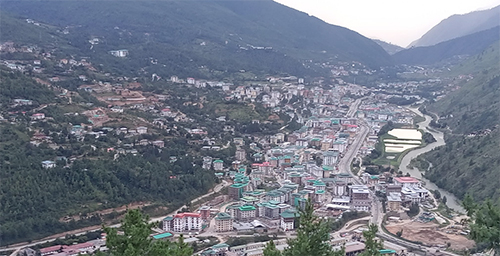Thimphu Thromde has intensified efforts to improve road safety and reduce traffic congestion in South Thimphu, undertaking a series of infrastructure projects that range from replacing outdated speed bumps with modern speed bumps to building underpasses and roundabouts.
The works, which began in mid-July, are part of a broader plan to create safer crossings for pedestrians while ensuring smoother traffic flow along the city’s busiest route.
Thimphu Thrompon, Ugyen Dorji, shared that the main reason behind reducing the size of the speed bump is to reduce the traffic congestion
“The bumps are being redesigned to meet international standards, which will also help lower vehicle maintenance costs. Many of the newer vehicles imported into the country have low ground clearance, and the existing high bumps often damage their bodies while unnecessarily slowing down traffic,” he added.
One of the most visible changes has been at the city bus stops along the southern stretch of the capital.
At Bap Lhakhang, the earlier speed bump was removed and replaced with a zebra crossing. At Gochukha, Tshalu Barp, and Tshalu Marphey bus stops, older bumps were replaced with new, better-designed speed bumps combined with marked pedestrian crossings.
Similarly, near Ola Rongchu, a speed bump that previously stood near Penchu Car Wash was relocated to align with the bus stop, ensuring both vehicular safety and pedestrian convenience.
These upgrades come on the back of two major projects completed earlier this year. At Changbangdu, the removal of the old speed bump paved the way for the construction of a pedestrian underpass at the Changjiji bridge, completed between January and April 2025 at a cost of Nu 1.1 million.
Thrompon Ugyen said, “After launching the bus priority lane, we kept on surveying and getting feedbacks to improve further. We installed CCTV to get data of where and how the traffic congestion is and the feeds from the CCTV clearly showed that the Changbangdu bump and the zebra crossing was creating a lot of traffic jam during the peak hours.”
He said that the bus priority lane was suspended in order to improve the hindrances, and once all the issues are addressed, Thromde will reintroduce the bus priority lane.
Meanwhile, a busy U-turn on the expressway leading to Lower Babesa and Debsi was redesigned into a roundabout between February and May 2025, a project that cost Nu 3.6 million. Both initiatives were aimed at reducing accidents, easing traffic bottlenecks, and offering safer alternatives for pedestrians.
Looking ahead, the Thromde has set its immediate focus on the S-Doebum Lam stretch, which extends from Lungtenzampa to The Living Monument. A traffic study conducted jointly with the Ministry of Infrastructure and Transport found that this corridor experiences the highest traffic volumes in the city, often leading to brief but significant backlogs during peak hours (morning and evening).
The congestion has been attributed to a combination of factors such as the heavy inflow of vehicles from the city’s outskirts, multiple speed bumps and crossings interrupting traffic flow, the lack of service lanes for lower settlement commuters, and limited options for traffic diversions.
To address these concerns, Thromde has drawn up a plan to replace existing bumps with new speed bumps and crossings at strategic locations such as the Helipad and the new BNB branch office.
Proposals are also underway to identify locations for footbridges or additional underpasses, alongside road improvements between the City Bus Service Office and the Bhutan Oil Distributor (BOD).
While South Thimphu has been prioritized, the northern stretch of the capital has not been overlooked. Plans are in place to remove existing bumps along the Zilukha-Dechenphodrang-North Doebum Lam corridor and pilot the use of plastic speed bumps.
Existing zebra crossings will be reviewed, with new installations expected near bus stops.
Thromde also intends to upgrade road conditions across North Thimphu to meet right-of-way standards, ensuring smoother and safer traffic movement.
In the city center, broader improvements are on the horizon. These include road widening projects, enhanced road marking, installation of traffic signage, and a reassessment of on-street and off-street parking arrangements.
Collectively, these steps aim to balance the needs of pedestrians, commuters, and businesses in the capital’s busiest zones.
Despite these promising developments, Thromde acknowledges several persistent challenges. These include limited policies and technical guidelines for urban transport, a shortage of mobility experts, financial constraints, and gaps in public cooperation. Compounding the challenge is a lack of adherence to traffic rules by some drivers, and limited awareness among road users about existing regulations.
Even so, the ongoing works represent a significant shift in urban planning for the capital.
By investing in road safety and traffic flow improvements, particularly in the high-pressure zones of South Thimphu such as the express-way, Thromde is signaling its determination to meet the demands of a growing city.
Thimphu Thromde shared that they remain hopeful that with continued support from both the government and the public, the capital will see meaningful progress towards safer, more efficient mobility in the years ahead.
 The Bhutanese Leading the way.
The Bhutanese Leading the way.



